Class 10 History Chapter 3 Notes - The Making of a Global World
| Table of contents |

|
| Introduction |

|
| The Pre Modern World |

|
| The Nineteenth Century (1815-1914) |

|
| The Inter-war Economy |

|
| Rebuilding a World Economy: The Post-war Era |

|
Introduction
A global world refers to a system in which economies, cultures, and societies across the globe are interconnected and interdependent.
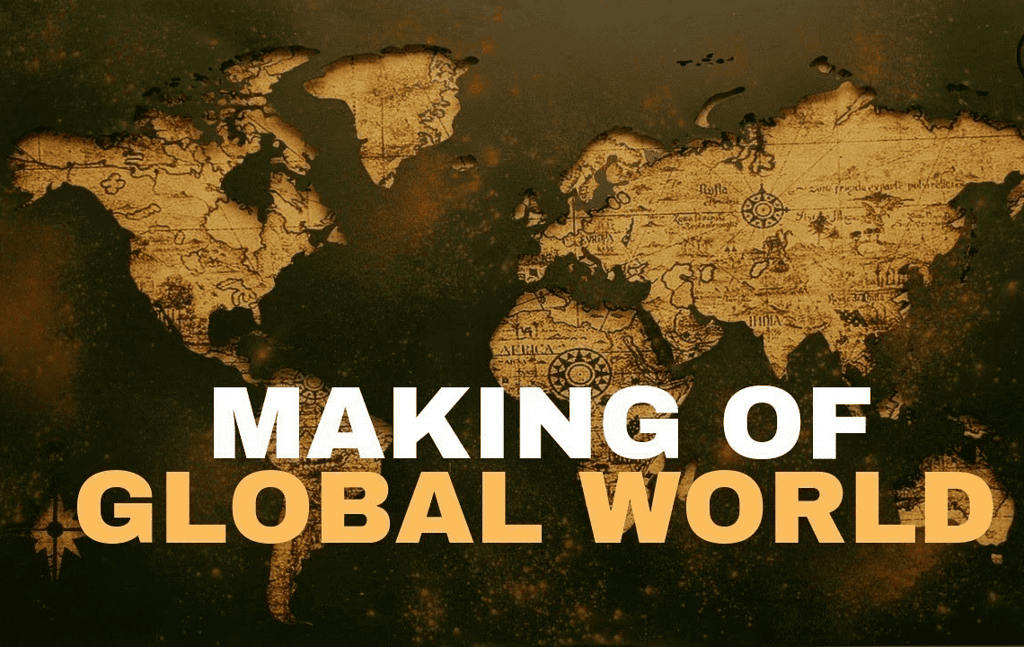 This interconnectedness is facilitated through trade, communication, technology, and migration, leading to increased interaction and exchange among people from different regions.
This interconnectedness is facilitated through trade, communication, technology, and migration, leading to increased interaction and exchange among people from different regions. - The chapter examines how historical events and processes, such as colonialism, industrialization, and technological advancements, contributed to the development of this global network, shaping the contemporary world economy and cultural landscape.
The Pre Modern World

- Globalization, often associated with the past 50 years, has a much longer history involving trade, migration, and the movement of people and capital.
- Trade, migration, the movement of capital, and the spread of ideas and diseases have all contributed to globalization.
- Evidence of globalization can be found as far back as 3000 BCE.
- Cowries from the Maldives were used as currency in China and East Africa for over a millennium.
- The long-distance spread of disease-carrying germs can be traced back to the seventh century.
- By the thirteenth century, globalization was an unmistakable link between different parts of the world.
 Cowries Currency
Cowries Currency
Globalization is the process by which ideas, knowledge, information, goods and services spread around the world. In business, the term is used in an economic context to describe integrated economies marked by free trade, the free flow of capital among countries and easy access to foreign resources, including labor markets, to maximize returns and benefit for the common good.
Silk Routes Link the World
- Silk routes are significant examples of pre-modern trade and cultural connections across the globe. The term 'silk routes' highlights the importance of Chinese exports heading west.
- Historians have identified multiple silk routes, both overland and sea, connecting vast Asian regions, and linking Asia with Europe and North Africa.
- These routes were operational before the Christian Era and flourished until the 15th century.
- Alongside silk, Chinese pottery, Indian and Southeast Asian textiles and spices also traveled these routes. In return, gold and silver flowed from Europe to Asia.
- Trade routes were often accompanied by cultural exchanges, with Christian and Muslim missionaries travelling these routes to Asia.
- Buddhism, which originated in eastern India, also spread in multiple directions through the silk routes.
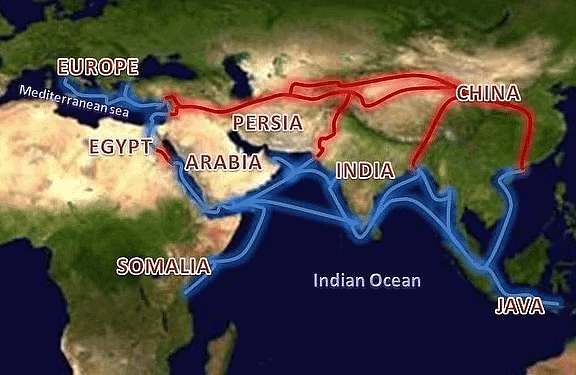 Silk Route
Silk Route
Food Travels: Spaghetti and Potato
- Traders and travellers introduced new crops to the lands they travelled.
- Even ‘ready’ foodstuff in distant parts of the world might share common origins like spaghetti and noodles or, perhaps, Arab traders took pasta to 5th century Sicily, an island now in Italy.
- Similar foods were also known in India and Japan, so the truth about their origins may never be known. Yet such guesswork suggests the possibilities of long-distance cultural contact even in the pre-modern world.
- Many of our common foods such as potatoes, soya, groundnuts, maize, tomatoes, chilies, sweet potatoes, and so on were not known to our ancestors until about five centuries ago.
- These foods were only introduced in Europe and Asia after Christopher Columbus accidentally discovered the vast continent that would later become known as the Americas.
 Potato Famine in Ireland 1845
Potato Famine in Ireland 1845
Conquest, Disease, and Trade
Before the sixteenth century, the Indian Ocean was a hub of bustling trade, with goods, people, knowledge, and customs crisscrossing its waters. The Indian subcontinent was central to these trade flows, playing a crucial role in the networks. However, the entry of Europeans in the sixteenth century helped expand or redirect some of these flows towards Europe.
The Impact of European Exploration
- In the sixteenth century, European sailors discovered a sea route to Asia and successfully crossed the western ocean to America, shrinking the pre-modern world significantly.
- America, previously cut off from regular contact for millions of years, began to transform trade and lives with its vast lands and abundant crops and minerals.
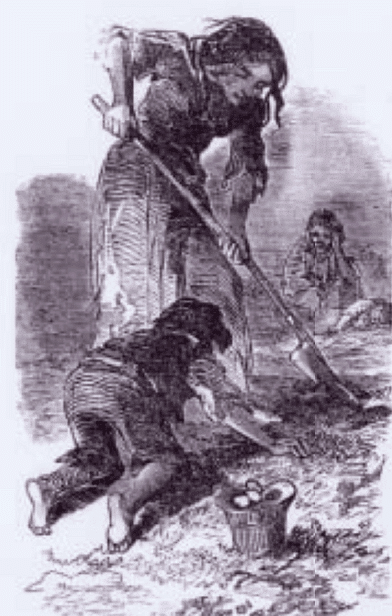 Precious Metals and European Wealth
Precious Metals and European Wealth
- Precious metals, particularly silver from mines in present-day Peru and Mexico, enhanced European wealth and financed trade with Asia. Legends
- Spread in the seventeenth century about South America’s fabled wealth, such as the El Dorado, sparked many expeditions in search of these riches.
Conquest and Colonization
- By the mid-sixteenth century, the Portuguese and Spanish conquest and colonization of America were decisively underway.
- European conquest was not solely due to superior firepower; the most powerful weapon of the Spanish conquerors was the germs, such as smallpox, they carried with them.
The Role of Germs in Conquest
- America's original inhabitants, due to their long isolation, had no immunity against these diseases that came from Europe.
- Smallpox, in particular, proved deadly, spreading deep into the continent ahead of any European arrivals. It killed and decimated whole communities, paving the way for conquest.
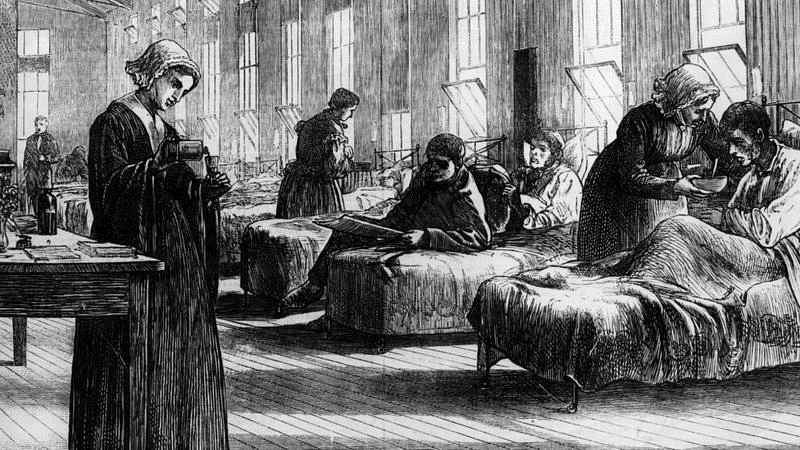 Smallpox in America
Smallpox in America
Economic and Social Conditions in Europe
- By the eighteenth century, Europe was experiencing poverty and hunger, with crowded cities and widespread deadly diseases.
- Religious conflicts were common, and religious dissenters faced persecution, prompting thousands to flee Europe for America.
The Shift in Trade Centers
- By the eighteenth century, plantations in America, worked by slaves captured in Africa, were producing cotton and sugar for European markets.
- China and India were among the world’s richest countries and preeminent in Asian trade. However, from the fifteenth century, China is said to have restricted overseas contacts and retreated into isolation.
The Rise of Europe as the Centre of Trade
- The reduced role of China and India and the rising importance of the Americas gradually moved the centre of trade westwards, with Europe emerging as the centre of world trade.
The Nineteenth Century (1815-1914)
- The nineteenth century saw significant transformations driven by economic, political, social, cultural, and technological factors.
- Economic flows are categorized into three types:
1. Trade flow: Primarily involved the exchange of goods like cloth and wheat.
2. Labour flow: The migration of people seeking employment.
3. Capital flow: Investments made over long distances, both short-term and long-term. - These three flows were interconnected and had a profound impact on people's lives, though labour migration was sometimes more restricted compared to goods and capital.
- Understanding these flows together provides a clearer picture of the nineteenth-century world economy.
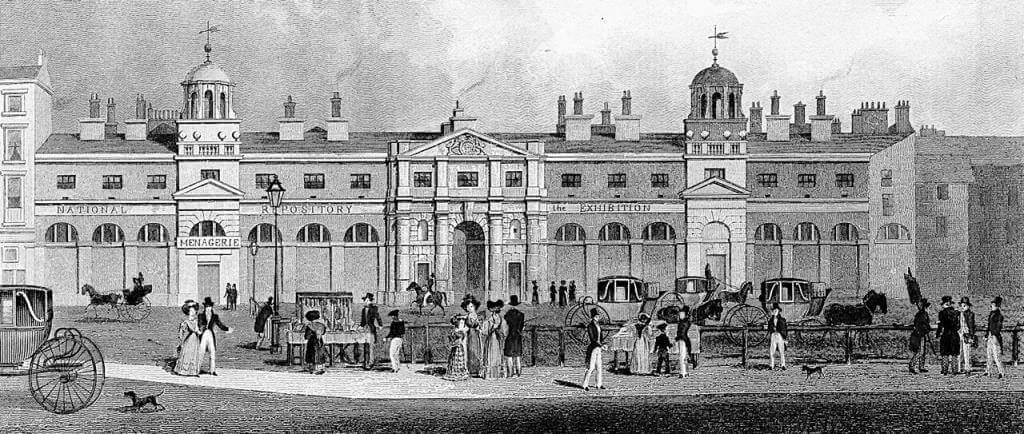 The Nineteenth Century
The Nineteenth Century
A World Economy Takes Shape
- Traditional self-sufficiency in food became a challenge in 19th-century Britain.
- Population growth increased demand for food, and industrial expansion raised agricultural product demand.
- The government, under pressure from landed groups, restricted corn imports through the 'Corn Laws.'
- The abolition of these laws led to cheaper imported food, causing British agriculture to lose competitiveness.
- Uncultivated land increased, and many workers lost jobs, moving to cities or overseas. Abolition led to a rise in food consumption and increased imports.
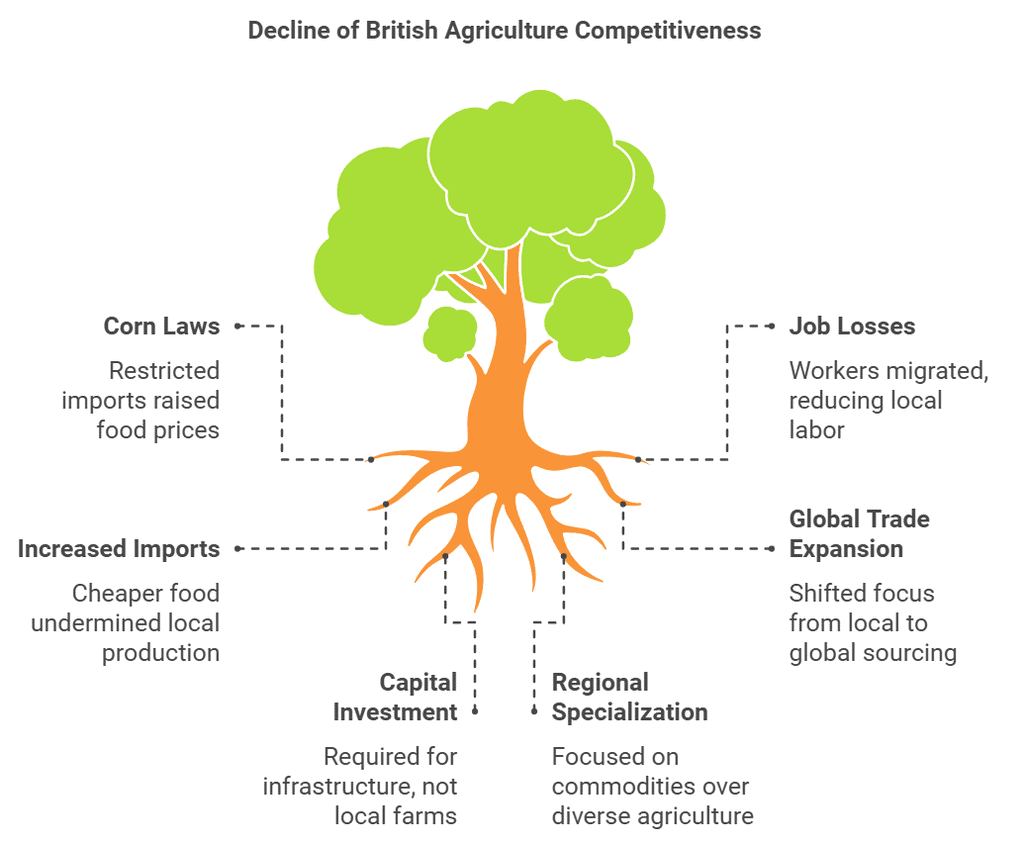
- Worldwide, lands were cleared and food production expanded to meet British demand. Capital from financial centres like London was essential for railways, harbours, and settlements.
- Nearly 50 million people emigrated from Europe to America and Australia. Globally, an estimated 150 million people left their homes in search of a better future.
- A global agricultural economy emerged, with changes in labour, capital flows, ecologies, and technology. Food sourcing shifted from local to distant locations, transforming agriculture and transportation.
- British Indian government's irrigation canals in west Punjab turned semi-desert areas into fertile lands. Peasants from various parts of Punjab settled in Canal Colonies, cultivating wheat and cotton for export.
- World trade multiplied 25 to 40 times between 1820 and 1914. Nearly 60% of this trade comprised primary products like wheat, cotton, and minerals.
- Rapid regional specialization in commodities, such as cotton and rubber, fueled the expansion of global trade.
Role of Technology
- Role of technology in the 19th century transformed. Important inventions: railways, steamships, telegraph.
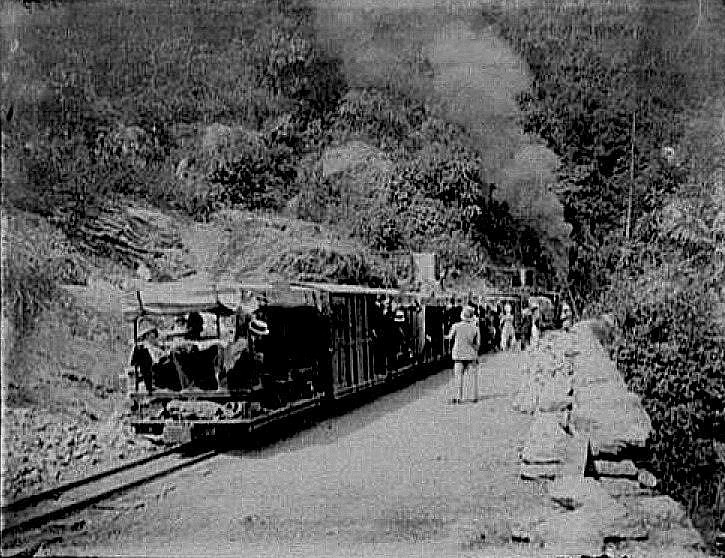
- Technological advances are influenced by social, political, and economic factors.
- Colonization stimulated new investments and improvements in transport. Faster railways, lighter wagons, and larger ships helped transport food more cheaply.
- Trade in meat is an example of this connected process. Previously, live animals were shipped from America to Europe and then slaughtered. This was expensive and limited meat availability to the European poor.
- The development of refrigerated ships allowed for the transport of perishable foods over long distances. Animals were now slaughtered at the starting point and transported as frozen meat. This reduced shipping costs and lowered meat prices in Europe.
- Improved living conditions and access to a varied diet promoted peace and support for imperialism.
Late Nineteenth-Century Colonialism
- The late nineteenth century saw flourishing trade and expanding markets.
- The expansion of trade and closer relationship with the world economy had a darker side.
- Many parts of the world experienced loss of freedoms and livelihoods.
- European conquests in the late nineteenth century led to painful economic, social, and ecological changes.
- European powers met in Berlin in 1885 to divide up Africa- Britain, France, Belgium, and Germany became new colonial powers.
- US also became a colonial power by taking over colonies previously held by Spain.
- One example of the destructive impact of colonialism on the economy and livelihoods of colonized people.
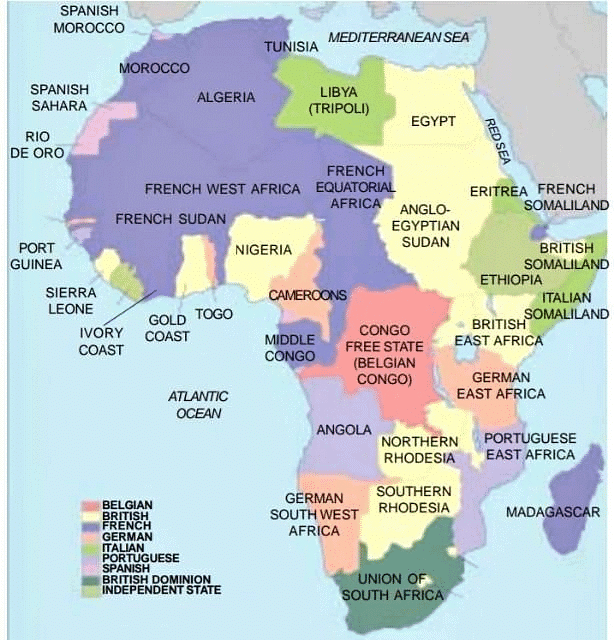 Map of Colonial Africa at the End of the Nineteenth Century
Map of Colonial Africa at the End of the Nineteenth Century
Rinderpest, or the Cattle Plague
1. Impact of Rinderpest in Africa (1890s):
- Rinderpest, a cattle plague, spread rapidly in 1890s Africa, highlighting European imperial influence.
- The disease reshaped lives and economies, showcasing the broader impact of conquest on societies.
 Rinderpest in Africa
Rinderpest in Africa
2. African Livelihoods in Historical Context:
- Historically, Africa had abundant land and a small population sustaining livelihoods through land and livestock.
- Wages were uncommon, as people with land and livestock found little incentive to work for wages.
3. European Attraction to Africa in Late 19th Century:
- Europeans were drawn to Africa for its vast land and mineral resources, aiming to establish plantations and mines.
- The unexpected challenge was a labor shortage, hindering European economic goals.
4. Recruitment and Retention of Labor:
- To address labor shortages, heavy taxes were imposed, compelling people to work on plantations and mines.
- Inheritance laws were changed, displacing peasants from land and pushing them into the labor market.
5. Impact of Rinderpest:
- Rinderpest, entering from British Asia, devastated African cattle, killing 90% along its westward path.
- Loss of cattle shattered African livelihoods, allowing planters, mine owners, and colonial governments to monopolize resources.
6. Manipulation of Scarce Resources:
- Rinderpest enabled European colonizers to control scarce cattle resources, consolidating power and forcing Africans into the labor market.
- The conquest and subjugation of Africa were facilitated by manipulating essential resources.
7. Broader Impact of Western Conquest:
- Similar stories of conquest's impact unfolded in other parts of the 19th-century world.
- Western imperial forces leveraged disruptions like rinderpest to reshape societies and consolidate control.
Indentured Labour Migration from India
- Indentured labour migration from India occurred in the 19th century.
- Indian and Chinese labourers went to work on plantations, mines, and construction projects.
- Indian indentured labourers were hired under contracts and promised return travel to India after five years.
 Labour Migration from India
Labour Migration from India
- Indian indentured workers mainly came from eastern Uttar Pradesh, Bihar, central India, and Tamil Nadu.
- The main destinations for Indian indentured migrants were the Caribbean islands, Mauritius, and Ceylon.
- Agents recruited workers and provided false information about destinations and working conditions.
- Conditions on the plantations were harsh and workers faced legal rights issues.
- Some workers developed new forms of self-expression and cultural fusion.
- Many workers stayed on after their contracts ended or returned to India briefly before settling in the new country.
- India's nationalist leaders opposed indentured labor migration and it was abolished in 1921.
- Descendants of Indian indentured workers faced a sense of loss and alienation in the Caribbean islands.
Indian Entrepreneurs Abroad
- Indian entrepreneurs and some bankers like Nattukottai and Chettiars financed the export of agriculture to Central and Southeast Asia.
- They even followed the Europeans to Africa.
- The Industrial Revolution in England changed the balance of trade between England and India.
- Indian handicrafts and agriculture were destroyed, and Britain enjoyed a trade surplus with India.
- Their exports increased and imports decreased.
Indian Trade, Colonialism and Global System
- Historically, India exported fine cotton to Europe, but British industrialization led to demands for protectionist measures. Tariffs imposed by the British government on cloth imports caused a decline in the inflow of Indian cotton to Britain.
- British textiles faced stiff competition in international markets, as Indian textiles were excluded by tariff barriers. India's cotton textile export share declined from 30% in 1800 to less than 3% by the 1870s.
- While exports of manufactures decreased, raw material exports, particularly raw cotton, surged from 5% to 35% between 1812 and 1871. Indigo and opium, used for dyeing and trade with China, also became significant exports.
- Britain grew opium in India, exported it to China, and used the earnings to finance tea and other imports from China.
- Opium shipments to China became India’s major export in the 19th century.
- British manufacturers flooded the Indian market, and India's food grain and raw material exports to Britain increased.
- Britain maintained a trade surplus with India, using it to balance trade deficits with other countries globally.
- India played a crucial role in the late-19th-century world economy by helping Britain balance its trade deficits. Britain's trade surplus with India also financed home charges, covering private remittances, interest payments, and pensions of British officials in India.
The Inter-war Economy
The First World War (1914-18) was fought in Europe, but its impact was felt around the world. During this period, the world experienced widespread economic and political instability and another catastrophic war.
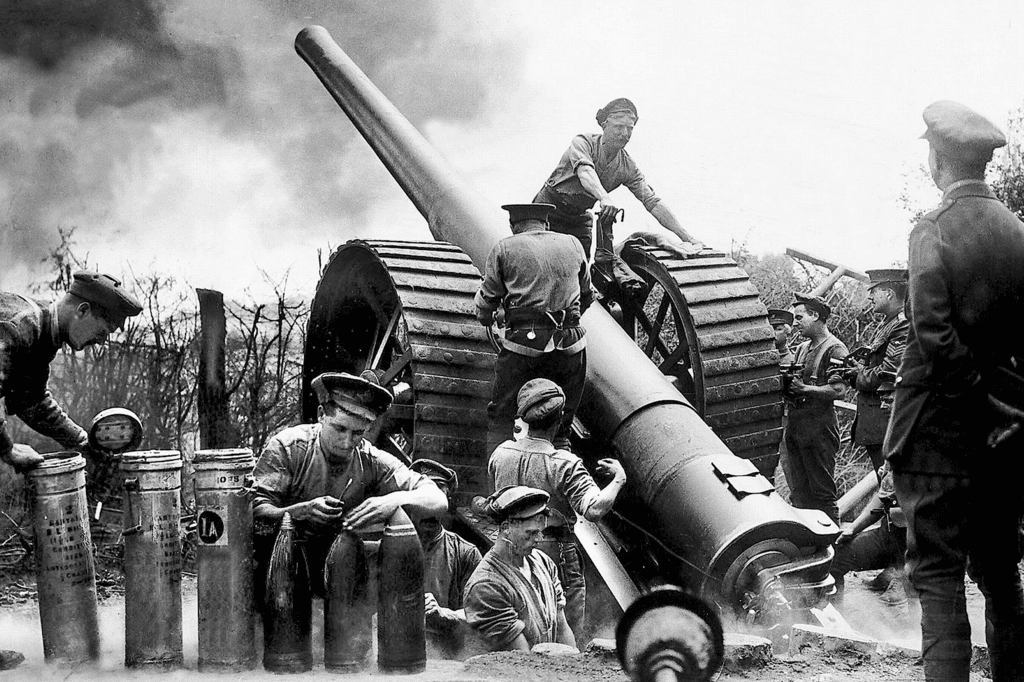 First World War
First World War
War Time Transformations
- The First World War was fought between the Allies (Britain, France, Russia) and the Central Powers (Germany, Austria-Hungary, Ottoman Empire).
- The first modern industrial war involved machine guns, tanks, aircraft, and chemical weapons.
- Millions of soldiers were recruited and transported to the frontlines.
- Unprecedented scale of death and destruction, with 9 million dead and 20 million injured.
- Reduction in able-bodied workforce and decline in household incomes.
- Industries were restructured to produce war-related goods, and societies were reorganized for war efforts.
- The war led to an economic disconnection between significant powers, with Britain borrowing large sums from US.
- The US transformed from an international debtor to an international creditor at the war's end.
Post-War Recovery
- After the war was over, production reduced and unemployment increased.
- In the US, war recovery was quicker.
- The ‘Assembly line’ method introduced by Henry Ford soon spread to the US and were also widely copied in Europe in the 1920s.
- Mass production lowered the costs and prices of engineered goods.
- There was a housing and consumer boom in the 1920s, which ultimately led to the Great Depression of 1929.
- Markets crashed in 1929 and led to the failure of banks and the crisis affected other countries.
- By 1933, over 4000 banks closed and between 1929-32 about 110,000 companies collapsed.
Rise of Mass Production and Consumption
- The US economy recovered quickly and resumed its strong growth in the early 1920s.
- Mass production is one of the important features of the US economy which began in the late nineteenth century.
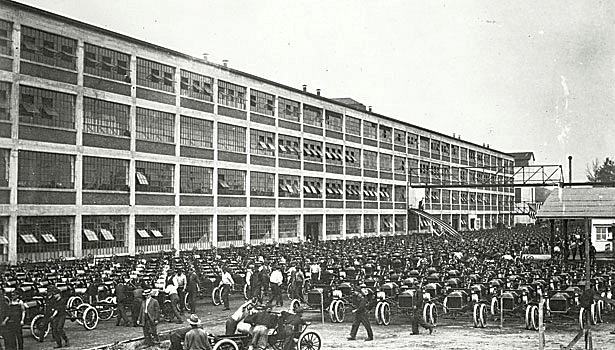 T-Model automobiles lined up outside the factory
T-Model automobiles lined up outside the factory
- Henry Ford is a well-known pioneer of mass production, a car manufacturer who established his car plant in Detroit.
- The T-Model Ford was the world’s first mass-produced car.
- Fordist industrial practices soon spread in the US and were also copied in Europe in the 1920s.
- The demand for refrigerators, washing machines, etc. also boomed, financed once again by loans.
- In 1923, the US resumed exporting capital to the rest of the world and became the largest overseas lender.
The Great Depression
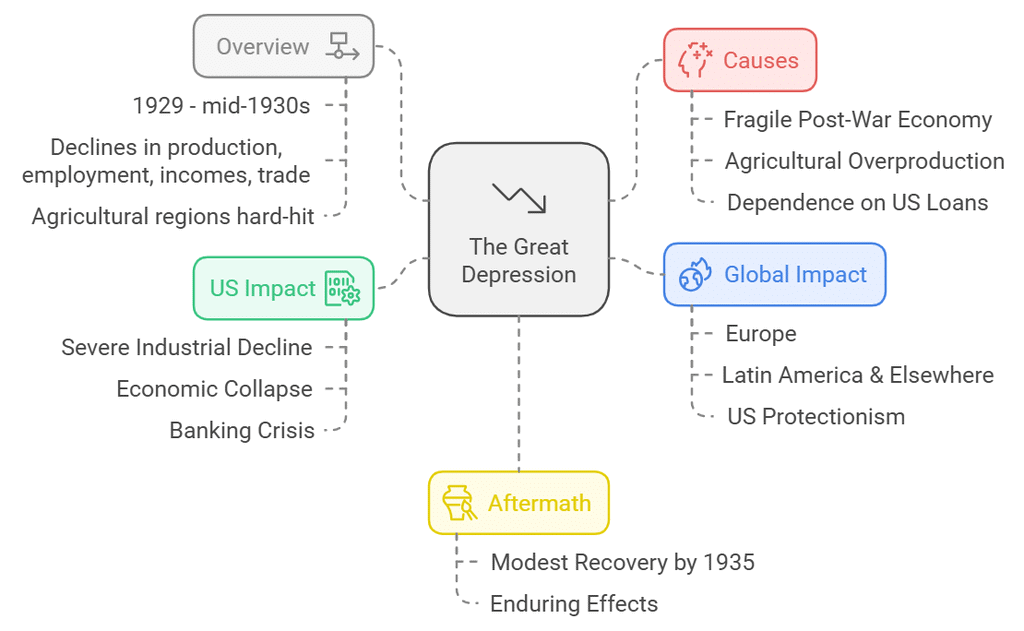
1. Overview (1929 - mid-1930s):
- The Great Depression began around 1929 and lasted until the mid-1930s.
- Most parts of the world experienced significant declines in production, employment, incomes, and trade.
- Agricultural regions and communities were particularly hard-hit due to a more prolonged fall in agricultural prices compared to industrial goods.
2. Causes:
- Fragile Post-War Economy: The global economy was already unstable after World War I.
- Agricultural Overproduction: Farmers expanded production to maintain income as prices fell, leading to market gluts and further price drops. Much farm produce rotted unsold.
- Dependence on US Loans: Many countries financed investments through US loans in the 1920s. As the US economy faltered, overseas lenders withdrew funds, causing a financial crisis in loan-dependent countries.
3. Global Impact:
- Europe: Withdrawal of US loans led to the failure of major banks and currency collapses, notably the British pound sterling.
- Latin America & Elsewhere: The slump in agricultural and raw material prices deepened, exacerbating economic difficulties.
- US Protectionism: The US doubled import duties to protect its economy, further damaging global trade.
4. US Impact:
- Severe Industrial Decline: The US was the most industrially affected country. Falling prices led to reduced domestic lending and loan recalls.
- Economic Collapse: Many farms could not sell harvests; businesses failed, and households were ruined, losing homes, cars, and consumer goods.
- Banking Crisis: The US banking system collapsed, with over 4,000 banks closing by 1933. Between 1929 and 1932, approximately 110,000 companies failed.
5. Aftermath:
- Modest Recovery: By 1935, a modest economic recovery began in most industrial countries.
- Enduring Effects: The Great Depression had long-lasting impacts on society, politics, international relations, and people's psyche.
 The Great Depression
The Great Depression
India and the Great Depression
- The global economy was highly integrated by the early twentieth century.
- The depression had a significant impact on India's trade.
- India's exports and imports nearly halved between 1928 and 1934.
- Agricultural prices in India fell sharply, causing suffering for peasants and farmers.
- Peasants producing for the world market were hit the hardest.
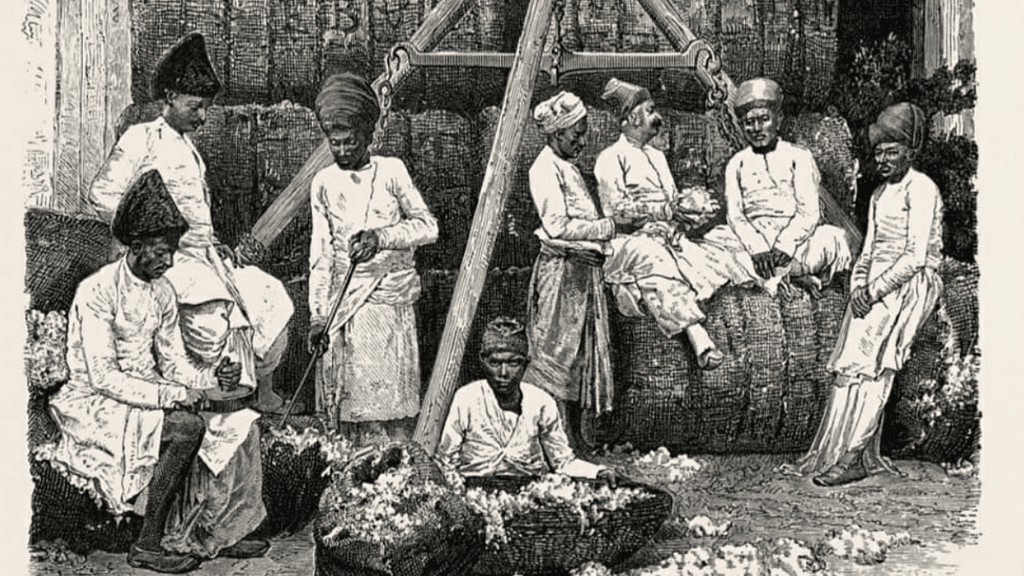 Great Depression in India, 1929
Great Depression in India, 1929
- Jute producers in Bengal faced a crash in prices, leading to increased indebtedness.
- Indian peasants sold precious metals and became exporters of gold.
- Indian gold exports helped promote global economic recovery, but did little for Indian peasants.
- The civil disobedience movement was launched by Mahatma Gandhi during the depression.
- Urban India fared better during the depression, with falling prices benefiting those with fixed incomes and industrial investment growing.
Rebuilding a World Economy: The Post-war Era
The Second World War broke out a mere two decades after the end of the First World War and once again, it led to destruction.1. Overview (1939 - 1945):
- The Second World War began just two decades after World War I.
- Fought between the Axis Powers (Nazi Germany, Japan, Italy) and the Allies (Britain, France, Soviet Union, US).
- It was a global conflict fought over six years on multiple fronts—land, sea, and air.
2. Scale of Death and Destruction:
- Approximately 60 million people (about 3% of the 1939 world population) died, with millions more injured.
- Most deaths occurred outside traditional battlefields, with more civilians than soldiers killed.
- Europe and Asia suffered extensive devastation; numerous cities were destroyed by aerial bombardment and artillery attacks.
- The war caused significant economic devastation and social disruption, making reconstruction a long and challenging process.
3. Post-War Reconstruction:
- US Dominance: The United States emerged as the leading economic, political, and military power in the Western world.
- Soviet Union's Rise: The Soviet Union, after significant sacrifices to defeat Nazi Germany, transformed from a backward agricultural nation into a world power, especially during the years when the capitalist world struggled through the Great Depression.
Post-war Settlement and the Bretton Woods Institutions
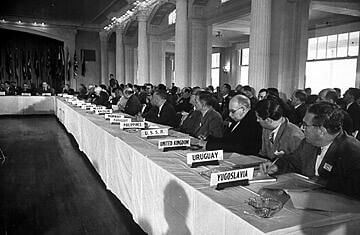 Bretton Woods Institution
Bretton Woods Institution
- To ensure a stable economy a framework was agreed upon at the United Nations Monetary and Financial Conference held at Bretton Woods in New Hampshire, USA.
- It established the International Monetary Fund (IMF) and the World Bank.
- The International Monetary Fund (IMF) deals with external surpluses and deficits of its member nations.
- The International Bank for Reconstruction and Development (popularly known as the World Bank) was set up to finance post-war reconstruction.
- The IMF and the World Bank commenced financial operations in 1947.
- Bretton Woods System was based on a fixed exchange rate.
- National currencies were pegged to the American dollar at a fixed rate.
- Decision-making in these institutions is controlled by the Western industrial powers largely by the US.
The Early Post-War Years
The Bretton Woods system, initiated after World War II, ushered in an era of remarkable growth in trade and incomes for Western industrial nations and Japan. Between 1950 and 1970, world trade saw annual growth rates exceeding 8%, ensuring stable economic expansion. The period also boasted low unemployment rates, averaging less than 5% in most industrial countries. The Mount Washington Hotel in Bretton Woods, US, hosted the pivotal conference that shaped this economic landscape. Additionally, there was a global spread of technology and enterprise during these decades, as developing countries invested significantly to catch up with advanced industrial nations.
Decolonisation and Independence
- After World War II, many parts of Asia and Africa were still under European colonial rule.
- In the following two decades, most colonies gained independence but faced challenges like poverty and resource shortages due to prolonged colonial rule.
- The IMF and World Bank, initially designed for industrial countries, struggled to address the developmental needs of newly independent nations.
- With Europe and Japan rebuilding, attention shifted to developing countries in the late 1950s.
- Despite gaining independence, former colonies faced challenges as former colonial powers continued to control vital resources.
- Developing nations, not benefiting from Western economic growth, formed the Group of 77 (G-77) to demand a New International Economic Order (NIEO).
- The NIEO aimed for real control over natural resources, more development assistance, fairer prices for raw materials, and improved market access for their goods in developed countries.
End of Bretton Woods and the Beginning of ‘Globalisation’
1. US Economic Strain:
- Rising costs of overseas involvements weakened the US financially.
- The US dollar lost confidence as the world's principal currency.
- Inability to maintain its value in relation to gold led to the collapse of fixed exchange rates.
2. Shift in International Financial System (Mid-1970s):
- Developing countries faced challenges borrowing from Western commercial banks.
- Shift from international institutions to private lending institutions.
- Resulted in periodic debt crises, especially impacting Africa and Latin America.
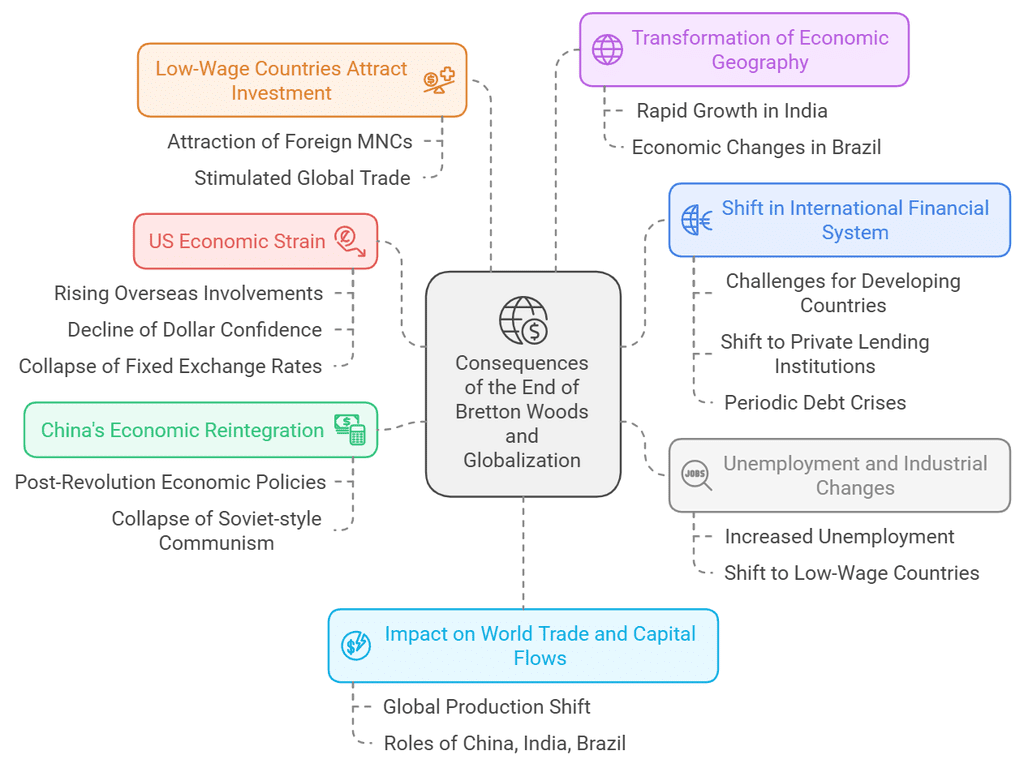
3. Unemployment and Industrial Changes (Mid-1970s - Early 1990s):
- Rising unemployment in the industrial world during the mid-1970s to the early 1990s.
- Multinational Corporations (MNCs) started shifting production to low-wage Asian countries.
4. China's Economic Reintegration (Post-Revolution Era):
- China, isolated since its 1949 revolution, re-entered the world economy with new economic policies.
- Collapse of Soviet-style communism in Eastern Europe contributed to global economic integration.
5. Low-Wage Countries Attract Investment:
- Countries with low wages, like China, became attractive for foreign MNCs.
- Relocation of industries to low-wage countries stimulated global trade and capital flows.
6. Transformation of Economic Geography (Last Two Decades):
- Rapid economic transformation in countries like India, China, and Brazil.
- Significant changes in the world's economic geography.
7. Impact on World Trade and Capital Flows:
- Relocation to low-wage countries contributed to the global production shift.
- China, India, and Brazil played key roles in the transformed world economic landscape.
|
94 videos|630 docs|79 tests
|
FAQs on Class 10 History Chapter 3 Notes - The Making of a Global World
| 1. What were the main features of the pre-modern world economy? |  |
| 2. How did the Industrial Revolution impact the global economy in the nineteenth century? |  |
| 3. What were the economic challenges faced during the inter-war period? |  |
| 4. How did the post-war era contribute to the rebuilding of the global economy? |  |
| 5. What role did globalization play in shaping the modern world economy? |  |





















